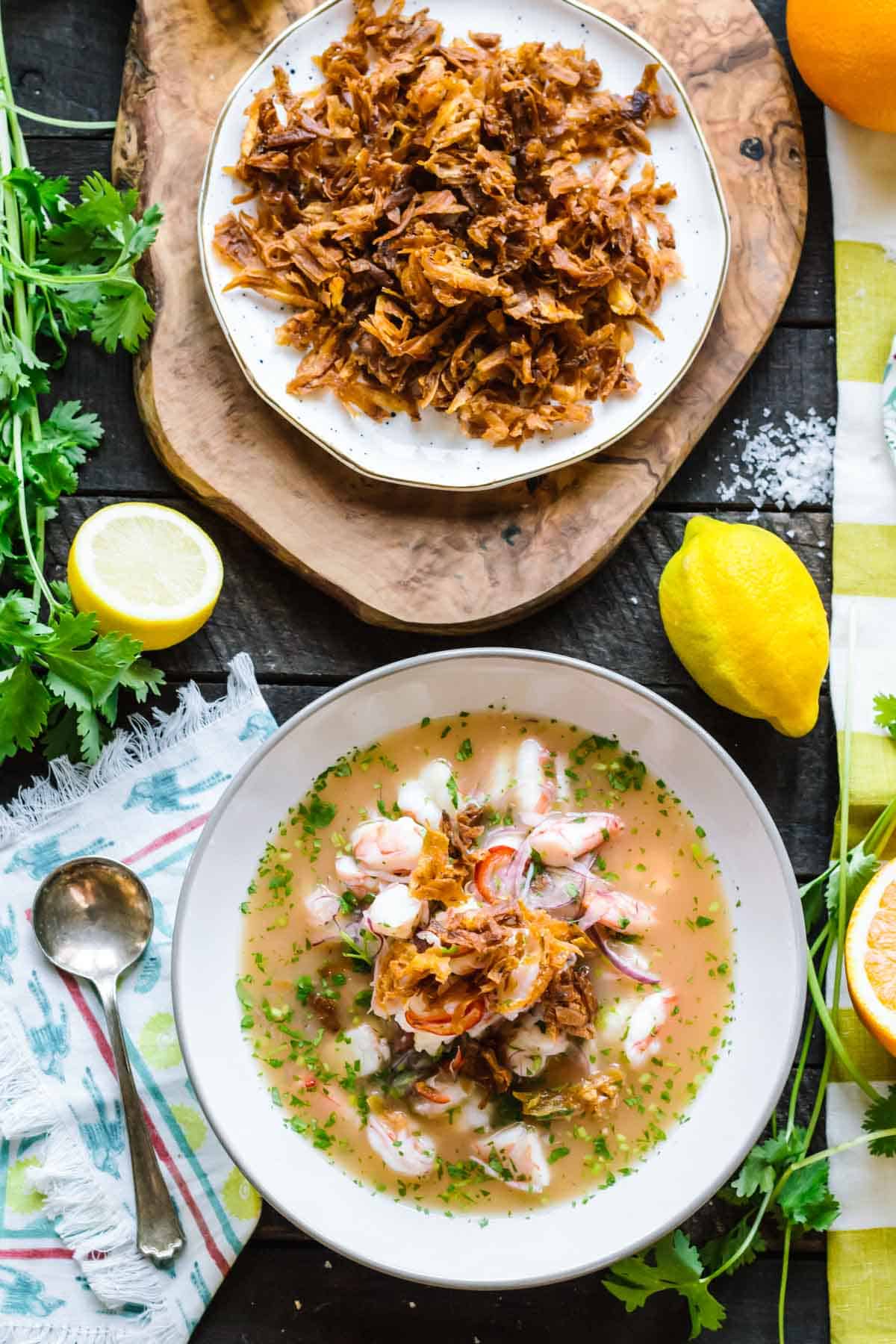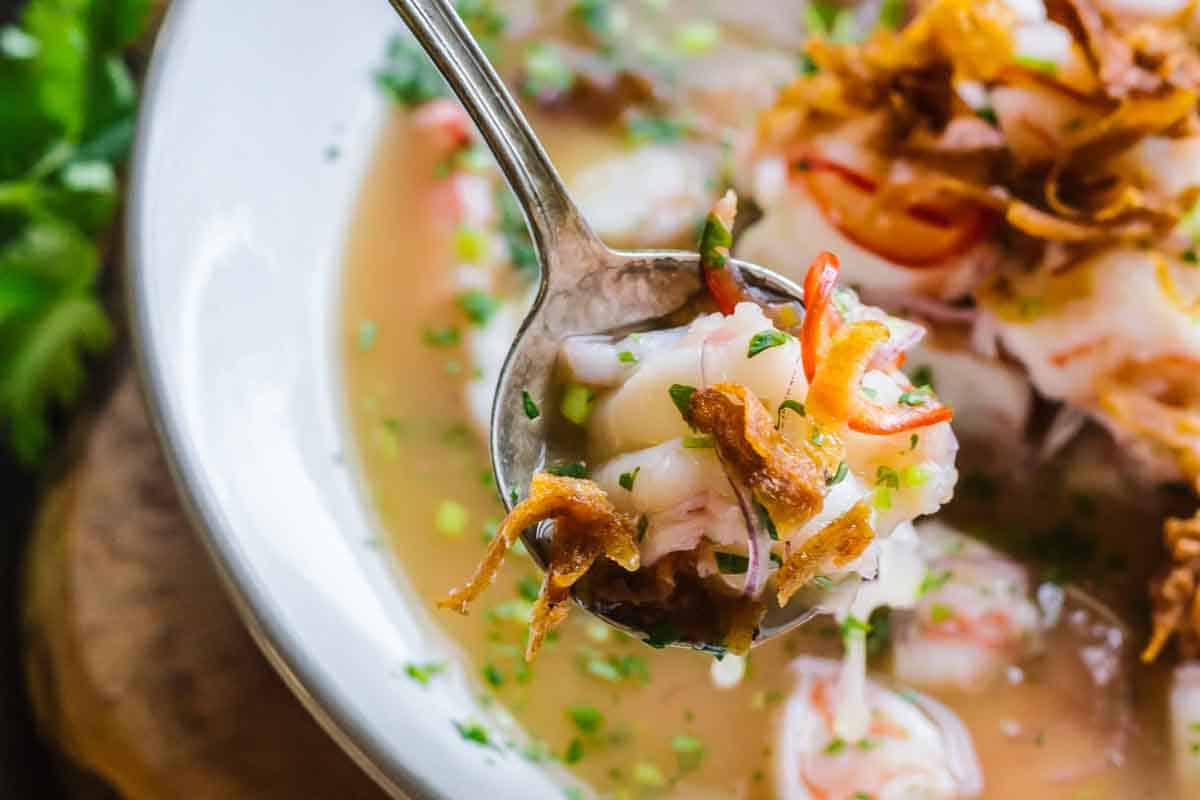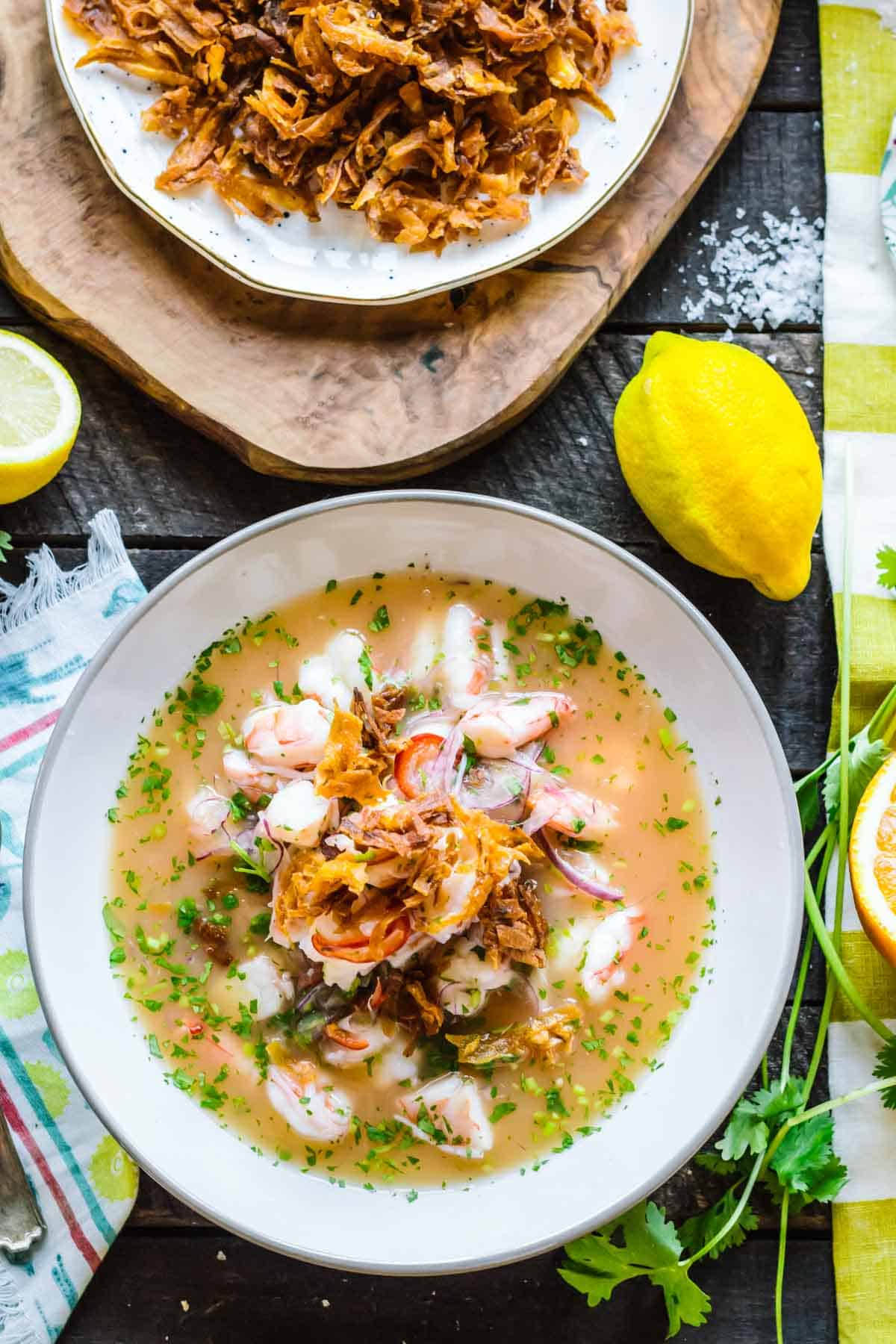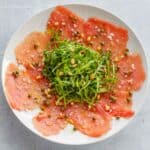Ecuadorian Shrimp Ceviche
This recipe for Ecuadorian shrimp ceviche is different from Peruvian ceviche in that it has more liquid, like a cold soup. It has a light, tangy flavor and is perfect for eating on the beach!

Ceviche is typically known as being a raw, or raw-ish preparation of seafood that gets "cooked," or more accurately, cured, by the citric acid present in citrus juice.
It's hard to beat a really good ceviche with super fresh fish that's full of bright flavors, like this scallop ceviche that lets an acidic marinade "cook" the raw scallops.
I learned how to make this version of ceviche from my friend Veronica, who is from Ecuador. It differs in that the shrimp are first boiled, then marinated in citrus and other flavorings, similar to my Louisiana style pickled shrimp.
Cooking the shrimp first ensures that they're safe to eat, and also gives them that irresistible snappy texture that you just can't get from marinating alone. This Ecuadorian ceviche is a great recipe for those who get nervous consuming raw fish and raw seafood.
Most ceviche recipes do not contain a lot of liquid, almost like a seafood salsa that can be scooped up with tortilla chips or a tostada shell. This version is more akin to a cold soup. It's meant to be very brothy and slurped up with a spoon.
The broth is very simple but still complex in flavor. Instead of fresh lime juice, this recipe uses lemon and orange juice.
This is the best shrimp ceviche recipe ever for a light meal or a snack on the beach!
Need another great shrimp recipe? Try this zesty citrus grilled shrimp, my favorite New Orlean's BBQ shrimp or this easy, buttery baked shrimp scampi.
Why This Recipe Works
- Different than Peruvian ceviche - it's brothy like a chilled soup!
- Shrimp is fully cooked before marinating for a better texture.
- Two types of citrus and a secret ingredient give a complex flavor.
- Great made in advance so the flavors can meld.

Ingredient Notes
- Red onion - You can substitute white onion (not yellow), but red adds a beautiful color.
- Hot Peppers - A Fresno pepper, jalapeño pepper or other small chili pepper will add a pop of heat, but you can omit if you're sensitive to spice.
- Fresh citrus juice - Using fresh lemon juice and fresh orange juice is a must. You'll need about 6 fresh lemons and 3 fresh oranges.
- Shrimp - Use fresh raw shrimp with tails and shells on for the most flavor. Peel and devein them first, but reserve the shells so they can be added to the broth, which gives it so much flavor. You can use frozen shrimp, just defrost them first.
- Ketchup - I know this is an unlikely ingredient in ceviche, but trust me, it adds extra body to the broth and a flavor you didn't know it needed.
- Green plantains - Make sure they're green and not yellow or brown. You can also skip frying the plantains altogether and purchase a bag of plantain chips instead.
*Full ingredient list with quantities is in the recipe card.
Helpful Equipment
- Large pot - Big enough to boil 2 pounds of shrimp.
- Large slotted spoon or spider to remove shrimp from the boiling water.
- Mixing Bowls

Step by step instruction
- Place the onions, chile pepper and lemon juice in a large bowl and set aside to marinate.
- Bring a medium pot of water up to a boil, place shrimp inside, and cook until just opaque, about 3 minutes. While the shrimp cook, prepare a bowl of ice water, then immediately shock the shrimp in the ice water to stop the cooking. Add the reserved shells and tails to the hot water, turn off the heat, and allow them to steep.
- Drain the shrimp, pat them dry, then slice into small pieces. Add chopped shrimp to the bowl with the onions, chiles and lemon juice, mix, then let marinate for about 15 minutes in the refrigerator. Leave the shrimp shells soaking in the water while it cools.
- When the water is no longer screaming hot, strain out the shells and add 3 cups of the poaching liquid to the shrimp, along with the ketchup, orange juice, salt, cilantro and stir until thoroughly combined.
- Taste for seasoning and adjust as needed. Cover and allow to chill in the refrigerator for at least 30 minutes, but overnight is best.
- When ready to serve, heat about 1 inch of oil in a heavy bottomed pan or a deep fryer to 375 degrees. Use the large holes of a box grater to coarsely grate the plantains. Working in batches, drop the grated plantains into the hot oil, and cook, stirring occasionally until golden brown and crisp. Remove with a slotted spoon and place on paper towels to drain. Sprinkle with salt, then repeat with the remaining plantains.
- To serve, ladle the ceviche into bowls, being sure to include plenty of liquid. Sprinkle with fried plantains and serve ice cold, with the remaining plantains on the side.
Tips For Success
- Serves 4 as a main dish and 8-10 as a snack or appetizer.
- Marinate and store ceviche in a non-reactive bowl or container. Use glass, stainless steel or ceramic to avoid a reaction with the materials and the acidic citrus juices.
- If you don't want to make your own plantain chips, you can purchase them or use corn nuts or popcorn instead!
Serving Suggestions
A crunchy topping is essential! Traditional ceviche in Ecuador is served with plantain chips, corn nuts or popcorn, but you can use tortilla chips, potato chips, Fritos or your favorite salty, crunchy snack!
For a complete meal, serve this shrimp ceviche with a side of Guacamole or Salsa Verde along with this Peruvian Grilled Chicken for dinner!
For a spicier ceviche, top with a little Jalapeño Hot Sauce.
This ceviche makes perfect beach food. I pack it in a thermos along with a bag of store bought plantain chips. Then just dish it out into cups, top them with crushed up chips and serve with spoons!

FAQ
Generally, medium to large shrimp work great, but it doesn't matter too much since you're be cutting them into small pieces. Using a high-quality wild caught sustainable shrimp is more important than size.
Absolutely! Just be sure to defrost them first
Store in an airtight container (preferably glass) in the refrigerator for up to 3 days.
Related Recipes
Did you LOVE this recipe? Please leave a star ⭐️ rating and comment!
Want to Save This Recipe?
Enter your email & I'll send it to your inbox.
By submitting this form, you consent to receive emails from Coley Cooks.
The Best Fresh Ecuadorian Shrimp Ceviche Recipe
Ingredients
- ½ small red onion halved and sliced paper thin
- 1 fresno jalapeño or other small chile, sliced paper thin (optional)
- ¾ cup fresh lemon juice from about 6 lemons
- 2 pounds 31/40 count shrimp peeled and deveined, including tails, (shells or tails reserved)
- ¼ cup ketchup
- 1 cup fresh orange juice from about 3 oranges
- 2 teaspoons salt plus more to taste
- 3 tablespoons finely minced fresh cilantro
- 2 green plantains peeled
- Vegetable oil for frying
Instructions
- Place the onions, chile pepper and lemon juice in a large mixing bowl and set aside to marinate.
- Bring a medium pot of water up to a boil, add the shrimp, and cook until just opaque, about 3 minutes. While the shrimp cook, prepare an ice bath, then immediately shock the shrimp in the ice water to stop the cooking. Add the reserved shells and tails to the water, turn off the heat, and allow them to steep.
- Drain the shrimp, pat them dry, then slice into bite sized pieces. Add to the bowl with the onions, chiles and lemon juice, mix, then let marinate for about 15 minutes in the refrigerator. Leave the shrimp shells soaking in the water while it cools.
- When the water is no longer screaming hot, strain out the shells and add 3 cups of the poaching liquid to the shrimp, along with the ketchup, orange juice, salt, cilantro and stir until thoroughly combined.
- Taste for seasoning and adjust as needed. Cover and allow to chill in the refrigerator for at least 30 minutes, but overnight is best.
- When ready to serve, heat about 1 inch of oil in a heavy bottomed pan or a deep fryer to 375 degrees. Use the large holes of a box grater to coarsely grate the plantains. Working in batches, drop the grated plantains into the hot oil, and cook, stirring occasionally until golden brown and crisp. Remove with a slotted spoon and place on paper towels to drain. Sprinkle with salt, then repeat with the remaining plantains.
- To serve, ladle the ceviche into bowls, being sure to include plenty of liquid. Sprinkle with fried plantains and serve ice cold, with the remaining plantains on the side.
Notes
- Serves 4 as a main dish and 8-10 as a snack or appetizer.
- Marinate and store ceviche in a non-reactive bowl or container. Use glass, stainless steel or ceramic to avoid a reaction with the materials and the acidic citrus juices.
- If you don't want to make your own plantain chips, you can purchase them or use corn nuts or popcorn instead!
Nutrition
This post may contain affiliate links.






Thanks for this easy-to-follow recipe. I grew up in Ecuador and so ceviche is one of my favorite comfort foods. I've never seen the grated version of the platano chips. It's a nice twist on the chifle. I'll have to try it.
Hey, Phil. So glad you like the recipe!! My friend Veronica actually told me after I posted this recipe that the only reason she did the plantains like that when she served it to us was because she was running out of time and thought it would be faster! Who knew! I love how they sort of float around in the bowl so you can get some in every bite. I'm glad this has your stamp of approval! Mutes Gracias 🙂
Coley that looks divine! We had ceviche for dinner tonight at a new Peruvian restaurant. So disappointing! Super salty and the fish was mediocre. I need to make this lovely Ecuadorian version to erase it from my palate. I love that you bring this to the beach! That, with a side of cold mango... aaaaaahhhh.
Oh man, that's such a bummer!! People are always stoked when I show up to the beach with ceviche, but I have to tell you, your mangoes were equally as popular!!